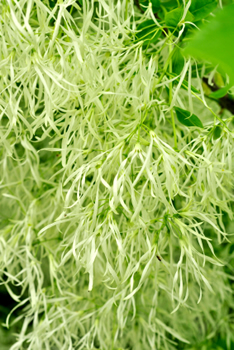Fringe tree Chionanthus virginicus

Old Man's Beard Tree with fringe flowers.
- Common Names
- Fringe tree , Old Man's beard, Snowdrop tree
- Botanical Name
- Chionanthus virginicus
- Family
- OLEACEAE
Medicinal Uses & Benefits of Fringe Tree
![]() How to Use|
Side Effects |
Plant & Garden|
How to Use|
Side Effects |
Plant & Garden|
- Medicinal Uses: * IBS
* Liver
- Properties: * Cholagogue * Vulnerary
- Parts Used: Dried back
- Constituents: bitters, saponins, phyllyrin, chionanthin
How to Use: Fringe tree
The roots of the fringe tree are dried and used to treat liver and gallbladder disease in traditional American folk medicine, often in combination with barberry and other herbs containing berberine. The root acts as a bitter,stimulating release of bile, which increases gastric secretion and improved appetite and digestion.
Hepatorestorative (liver supporting) and cholerectic (increasing bile) herbs such as St. Mary's thistle (Cnicus benedictus), fringe tree (Chionanthus virginicus) and schisandra (Schisandra chinensis) are an important part of treatment for IBS. 1
Preparation Methods & Dosage :decoction of the dried bark, fluid extracts
Fringe tree Side Effects: Avoid during gallstone attacks
Plant Description
Fringe tree, Chionanthus virginica is small tree or shrub that is native to Eastern North America. The genus Chionanthus is also found in the tropics and subtropics, in eastern Asia. Most of the tropical species are evergreen. The common name fringe tree, or Old man's bead refers to the white flowers with fringe-like petals.
Regional Traditions :North America *
History and Traditions & Folklore
Native Americans used Fringe tree bark as a poultice for healing wounds.- American Botanical Council. Bone, Kerry. Phytotherapy and Irritable Bowel Syndrome British Journal of Phytotherapy. " HerbalGram











